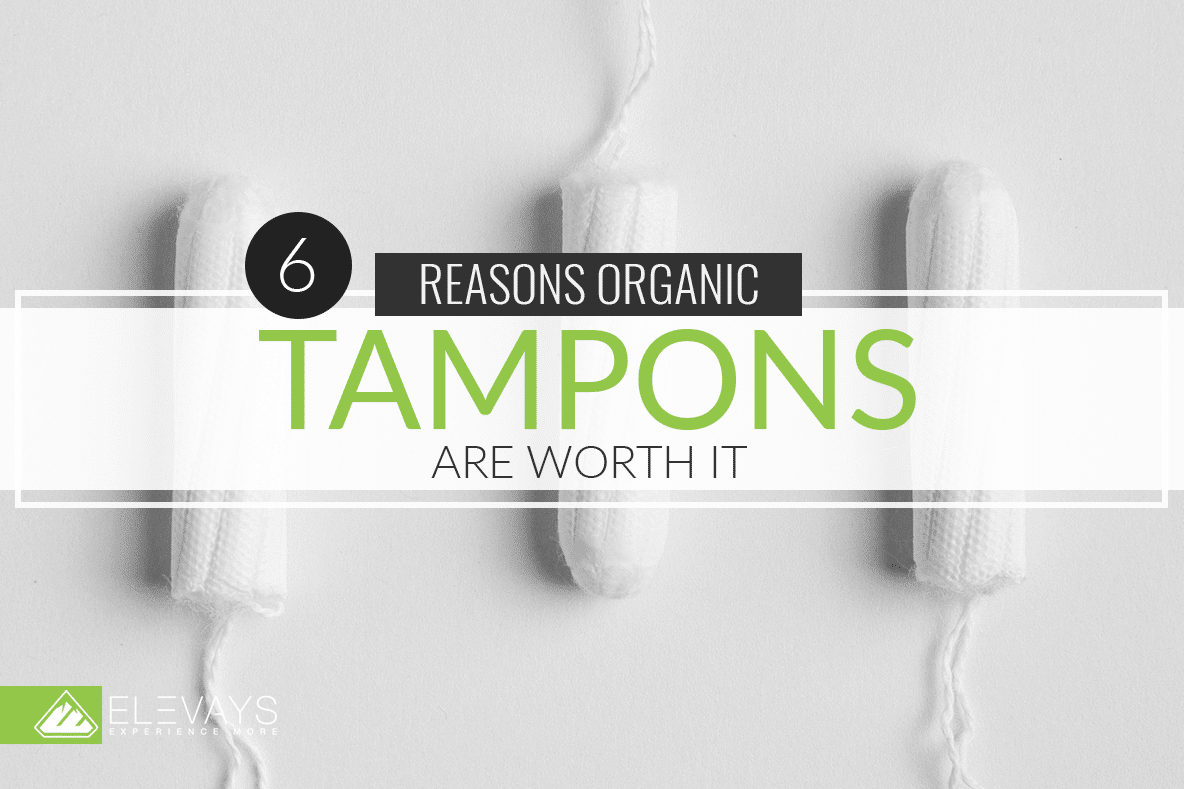Time to get up close and personal. Time to clear the air. It’s time to talk about that time.
No need to get squeamish — periods are just a fact of life, and while they’re maybe not our favorite subject, there are certainly ways to make that time of the month a little easier.
Now, there’s been a big push lately for women to go more natural with everything – from cosmetics to personal care products – and I couldn’t agree more. Finding natural ways to mitigate pain and discomfort or simply to keep you feeling fresh are incredibly important. After all, the monthly cycle is natural and healthy, so it makes sense to try to handle this part of life in a natural way, devoid of chemicals and toxins that may only bring problems down the road.
TRUTH BOMB:
You’re
Already killing it!
If You Were More Consistent With Your Wellness Routine, You’d Be Unstoppable.
That’s why this post is all about organic cotton tampons.
If you read our post on organic bedding and textiles, you may already have some background info on the benefits of organic cotton in general. But we’re going to dig a little further and see some of the actual benefits of organic cotton tampons, which types are the best organic tampons, and how they differ from your average, run-of-the-mill tampons.
But first, let’s go back to school with a little basic anatomy lesson.
Why Your Tampon Choices are Important
Don’t worry, we’re not going to take you all the way back to middle school and talk about the birds and the bees. Rather, we’re going to get a little bit more informative about what makes the vaginal environment so unique — and so uniquely sensitive to potential hazards.
As you well know, what makes tampons so effective is that they are inserted directly into the vagina to absorb blood. They keep your flow contained, so there’s generally less need to worry about leaks and many women find tampons to be more comfortable as well. Try going through a summer in the South with all that humidity while wearing a bulky pad. It’s a personal decision, but I. Just. Can’t. And lots of other women feel the same which is why we’re even talking about tampons in the first place.
One of the biggest factors to consider about tampons is that they come into direct contact with very sensitive, highly permeable internal tissue.
This tissue contains a high number of blood vessels and mucous membranes, all of which are incredibly efficient at carrying chemicals and other materials throughout the body. In fact, some studies have even been performed that showed that medications inserted into vulvar tissue have a much higher potency than oral medications, simply due to how fast vaginal tissue can absorb them!
This is all pretty amazing biology, but what implications does this have for your tampons?
Well, considering the chemical sensitivity that your vaginal tissue has, anything that is inserted and left in close contact with that tissue for an extended period of time has the potential to have strong effects on your body. And, since this is exactly how a tampon works, it’s critical that you know exactly what’s inside your tampon and what it may be doing to your system.
And now, with that bit of knowledge in hand, let’s take a look at the ingredients in conventional tampons.
The Lowdown on Conventional Tampons
Let’s get into the nitty-gritty of what actually goes into a conventional tampon.
It’s important to note that the FDA doesn’t monitor or require safety testing for feminine hygiene products. And, they also don’t require that tampon ingredients be disclosed to consumers. For that reason it’s hard to even know exactly what goes into your tampons. Kind of scary, right?
In general, tampons are made of cotton or synthetic fibers like rayon, or a blend of the two. But that doesn’t mean that’s all that’s in your tampons – and personally, I’m not a huge fan of synthetics like rayon in general but I definitely don’t want it in my tampons.
When conventional cotton is being processed for commercial use, it often goes through bleaching and other chemical processes that expose the fibers to toxic materials. And, while the FDA does recommend that tampons be free of pesticide residue, studies have shown that many conventional cotton tampons still contain trace amounts.
While the levels of pesticides and other residue found in these studies were fairly low, again, consider what part of the body these chemicals will be coming into contact with. That’s right — one of the most sensitive and absorbent areas of your body.
And further studies have shown that these types of residues and other chemical additives can cause a whole host of problems, from hormone disruption to general irritation and beyond. Let’s look closer at a few of these potential issues that conventional cotton tampons can cause.
The Hazards of Conventional Cotton Tampons
Since we’ve just spent some time discussing chemical and pesticide residues, we’ll start there and talk about how these affect your body.
First off, many tampons contain traces of the chemical dioxin, a known endocrine disruptor that can cause issues with your hormones. But they don’t just create imbalances — endocrine disruptors also exacerbate fertility issues, thyroid conditions, PCOS, hormonal and cystic acne, thyroid conditions, endometriosis, and even some forms of cancer. Pretty serious stuff.
And endocrine disruptors aren’t just found in the tampons themselves. Some tampons contain chemical fragrances that also contain endocrine disruptors, so in these types of tampons, you’re getting essentially a double-dose of problematic chemicals!
Then there’s also the issue of how tampons interact with your body’s actual ecology.
Your vaginal tissue is uniquely structured to be self-cleansing, with mucous membranes and bacteria-flushing functions that help your feminine area to stay healthy and free of harmful bacteria. Placing synthetic materials and chemical additives in close contact with your vaginal tissue for long periods of time disrupts this natural process, and can lead to serious problems long term.
No doubt you’re familiar with the infamous Toxic Shock Syndrome, or TSS. Generally this is caused by bacteria within the vaginal canal that is unable to escape, causing a severe infection which in some cases can result in death. Although no TSS case has been explicitly linked with conventional tampons, the synthetic materials in tampons can be a contributor to this type of adverse reaction.
On the less intense end of the spectrum, some women may experience other, more minor irritations as the result of conventional tampons. Your vulvar tissue is already a very sensitive part of the body, and any synthetic and potentially irritant material can lead to discomfort, rashes, and other irritation as a result of the close skin contact.
So there you have it — a whole laundry list of ways that conventional tampons can affect your body in highly negative ways. And if you’re discovering all this for the first time and you’re shocked, you’re not alone!
This is information that is not widely known, but I feel it’s incredibly important that women have the best, most up-to-date information about what we’re putting in our bodies, so we can make informed decisions that result in better health.
Which brings us to the part you’ve all been waiting for — the many other natural options such as organic cotton tampons, and the many advantages they offer.
The Upsides of Organic Cotton Tampons
Now that we’ve covered the downsides of conventional tampons, it’s time to explore the lighter side and get the full scoop on organic cotton tampons.
But first, what makes a tampon organic?
Well, it’s all in the content. Or, maybe a better way to put it would be — it’s all in knowing the content – or what’s not in the content. We already mentioned how it’s nearly impossible to know what goes into a conventional tampon, since the FDA doesn’t require that information to be listed.
But, since organic cotton has to go through strict federal guidelines in order to be labeled as organic, you know exactly what you’re getting with organic cotton tampons: pesticide-free, dioxin-free, all-cotton tampons that are far less likely to cause any of the above issues we’ve mentioned.
Let’s break down organic cotton tampons’ advantages in detail so you can see exactly how they’re preferable over the conventional alternatives:
- Organic cotton tampons don’t contain any pesticide residue. Since organic cotton goes through stringent examination to be labeled organic, you can be sure that it’s been purified of all pesticides during processing, and that no additional chemical additives were used during this process.
- Organic cotton tampons don’t contain endocrine-disrupting elements. Endocrine disruptors can cause problems with fertility, hormones, and are even linked to cancer. But with organic cotton tampons, you won’t find dioxin or any of the other harmful endocrine disruptors that you find in conventional cotton.
- Organic cotton tampons may lower the risk of TSS. Organic feminine products are free of synthetic elements and potentially-harmful ingredients, so they carry a much lower risk of toxic shock syndrome. This is because organic cotton tampons won’t have elements that increase your risk of bacteria and other infections.
- Organic cotton tampons are biodegradable. It’s possible to go green even with feminine products! Organic cotton tampons can be fully broken down by the environment, reducing waste and strain on our planetary resources.
- Many organic cotton tampons are better-constructed to reduce risk of fibers being left behind. When you’re using a conventional tampon, you’re already exposing your sensitive areas to toxic materials. So when you think about the possibility of some of these toxic elements being left behind even after the tampon is removed, you’re probably right in feeling a little freaked out! Some organic cotton tampons are constructed with a special weave that reduces this risk, you can worry less about toxic residues and fibers being left behind.
- Some women experience fewer hormonal issues after switching to organic cotton tampons. Although it’s not been tested or proven, many women claim that their severe menstrual symptoms (i.e., heavy cramping and excessive bleeding) lessened after making the switch to organic feminine products. Again, there aren’t yet any studies that back up these claims, but it is consistent with the knowledge that organic products are all free of hormone-disrupting toxins!
Really, we could sum it all up by saying: All the potential risks associated with conventional tampons are either lessened or completely removed by switching to organic cotton tampons.
And thankfully, due to ramped up interest in organic, environmentally-friendly, and all-natural alternatives to everyday products, there are more options than ever for organic cotton tampons.
So, Which is the Best Organic Tampon?
As far as organic cotton tampons go, there are plenty on the market, and many have overlapping benefits. So at the end of the day, it will be up to you to try them and see which offers you the most comfort and protection.
But as a starting point, here are our top 5 best organic tampons for you to try:
-
- Seventh Generation: This brand is pretty tried-and-true, as they’ve been in the business of producing natural and organic products for around 25 years. Their organic cotton tampons can be purchased with or without a biodegradable applicator, and you can find the a range of absorbencies.
-
- Lola: If you’re into subscription boxes, Lola makes purchasing organic cotton tampons super easy. They send you your preferred type of tampon each month, so you’re sure to have them on hand when it’s that time. Their tampons also come in several different absorbency levels, and you can even order a “variety box” that you or-make to suit your needs. Order them with or without the BPA-free plastic applicator.
-
- Natracare: These are the original organic cotton tampon, made with certified 100% organic cotton. Natracare tampons are completely perfume-free, chlorine-free, and biodegradable, so they’re also eco-friendly. Ajust like the others, you can get them with or without an applicator, and in various absorbencies. As an added bonus, you can buy online in bulk and save.
-
- The Honest Company: Not only are these tampons GOTS certified organic, they are also hypoallergenic, so they’re perfect for those of us with uber-sensitive skin. are completely free of chemicals and pesticides, as well as synthetic materials like rayon and polyester (so bye-bye, endocrine disruptors!). Purchase with or without the plant-based applicator, and in a variety of sizes.
-
- Organyc: These 100% organic cotton tampons are not just safe for your body, but they’re also environmentally-friendly. They are fully biodegradable and can even be composted if you’re into that. The applicator is cardboard for even more eco-friendliness, and you can choose from applicator or non-applicator, and your typical absorbency levels.
These are my picks for the best organic tampons, but there are probably more brands out there that are great. So experiment with a few and see which offers you the best in terms of comfort, absorbency, and functionality.
Other Natural Tampon Alternatives
So now that you’ve gotten the full skinny on organic cotton tampons, you may be wondering — what do I use if I don’t like using tampons at all?
Well, never fear — there are natural options out there for you even if you’re not a big tampon user. Most of the brands we mentioned above also carry organic cotton pads, which offer you the same level of toxin-free, 100% organic cotton protection.
Additionally, many women have been experimenting more with menstrual cups, which are inserted vaginally and collect the blood rather than absorbing it. If you want to try out a menstrual cup, be sure to purchase one that’s BPA-free and made from medical-grade silicone.
One big upside to menstrual cups is that they don’t carry any risk of TSS, but many women do have complaints that they can be difficult to insert or remove initially. A little practice usually clears this problem up, but it’s certainly something to be aware of if you’re getting ready to try one out.
Some companies are even experimenting with small, vaginal discs that are inserted in the vaginal canal, sit at the fornix and collect vaginal fluid similar to a menstrual cup. The main difference in these is where they sit — they don’t rest in the vaginal canal, but rather high up near the cervix, and can be worn up to 12 hours comfortably.
So even if you’re not a fan of tampons in general, you can always try one of these natural, alternative methods to conquer your flow without any fear of toxins or chemicals.
Reaping the Benefits of Organic Cotton Tampons
I realize this is a very frank look at a very personal topic — so if you hung in this far, kudos to you!
As time goes on and we begin to learn more and more about the nuances of our own anatomy, taking charge of how we handle menstrual cycles is increasingly important. We can’t control what manufacturers put into products, but we can choose products that we know are natural and will be better for long-term health, balance, and wellness.
Only you can control your own health — and awareness is the first step!
How are you taking charge of your menstrual health? Have you experimented with organic cotton tampons, and if so, what benefits have you noticed? Let us know in a comment below!
Sources:
- Women’s Voices for the Earth, (2013). Potential Health Effects of Toxic Chemicals in Feminine Care Products. Retrieved from: http://www.womensvoices.org/wp-content/uploads/2013/11/Chem-Fatale-Report.pdf
- The Natural Fertility Company, (2015). Tampons & Infertility – Are Your Feminine Care Products Affecting Your Fertility? Retrieved from: http://natural-fertility-info.com/tampons-infertility.html
- Wholefoods Magazine, (2016). Can Feminine Hygiene Products Be Toxic? Retrieved from: https://wholefoodsmagazine.com/haba/features-haba/can-feminine-hygiene-products-be-toxic/
- Tierno Jr, P. M., & Hanna, B. A. (1989). Ecology of toxic shock syndrome: amplification of toxic shock syndrome toxin 1 by materials of medical interest. Reviews of infectious diseases, 11(Supplement_1), S182-S187.









Tampons are regulated by the FDA as Class II medical devices. Why don’t you try a little fact-checking if you’re going to play Journalist?
https://www.fda.gov/consumers/consumer-updates/facts-tampons-and-how-use-them-safely
You may also want to check out what a GYNECOLOGIST who knows so much about VAGINAS that she wrote a WHOLE BOOK about them says about organic vs conventional tampons:
Then you may want to think about all the women you may be scaring into spending more money than they can afford to buy organic tampons, and the women who actually don’t have the money to buy organic tampons who you are just giving one more thing to worry about, which they really don’t need, and then you might want to do a little rewrite of this article based a bit more on facts and a tad less on speculation. And if you get that far, kudos to you! Only you can control your own bad writing!
FACTS:
1- Just because the FDA says something is safe doesn’t make it so. I was a pharmaceutical rep for one of the largest drug companies in America. I can give many examples of FDA approved drugs that had horrific outcomes for patients.
2- Just because someone is a doctor doesn’t mean everything they say is gospel.
3- Just because someone writes a book doesn’t mean they know what they’re talking about.
Here’s some insight into the readers of this site: They are highly educated and they are completely uninterested in following along with the status quo because something is “FDA approved” “the doctor said so” or “someone wrote a book about it.” These readers think critically. And I love that about them.
Let’s just look at ONE ingredient in conventional tampons. It doesn’t take rocket science to figure out that fragrance – a commonly used ingredient in tampons and also a hormone disruptor – is not a good idea to insert into your vagina. But by your comment, we should all just assume that’s a safe thing to do because the “FDA said so.”
The readers of this site desire to remove interferences to their optimal health. My goal is to expose areas where they might be (unknowingly) preventing their own progress in this area. It’s their decision what they do with the information.
I also deleted the link that you posted from the gynecologist. There’s so much wrong with that article I don’t even know where to begin. It’s also clearly a promotion for her upcoming book. And final thing: This is a natural health website. Just keep that in mind before you comment. We’re not about the status quo over here.